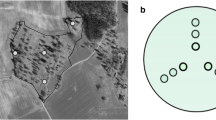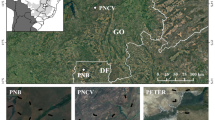Abstract
Using data from 46 sites in southern Finland and ordination methods, we examined plant-environment relationships in boreal mesic semi-natural grasslands at two spatial scales (grain sizes), using plots of 0.25 ha and 1 × 1 m. We applied the variation partitioning approach to determine the pure fractions of environmental variable groups and their joint effects on plant species compositional variation in the studied grasslands. The variables related to land-use intensity and high nutrient level (especially phosphorus) had a major role in explaining the species composition at both scales, although soil heterogeneity and habitat characteristics also accounted for a notable amount of the species compositional variation at the 0.25 ha grain size. At the 1 × 1 m grain size, the majority of the species compositional variation was related to the “pure” spatial differences between the studied grasslands (i.e. the site identity (dummy 0/1) variable), whereas the impacts of within-site variation of local environmental factors were considerably smaller. High nutrient levels and variables related to low land-use intensity, e.g. litter accumulation, were also significantly correlated with floristic variation at the 1 × 1 m grain size. Rare and declining grassland species are associated with low-nutrient grassland sites and patches. The main recommendation for the management planning of boreal semi-natural grasslands is that the first restoration attempts should be targeted to areas where nutrient levels, particularly that of phosphorus, are relatively low. Soil properties and plant species composition can provide useful guidelines for defining the correct management procedures for different sites.
Similar content being viewed by others
References
Aerts R, Chapin FS (2000) The mineral nutrition of wild plants revisited: a re-evaluation of processes and patterns. Adv Ecol Res 30:1–67
Anderson M, Gribble N (1998) Partitioning the variation among spatial, temporal and environmental components in a multivariate data set. Aust J Ecol 23:158–167
Austrheim G (2002) Plant diversity patterns in semi-natural grasslands along an elevational gradients in southern Norway. Plant Ecol 161:193–205
Austrheim G, Gunilla E, Olsson A, Grontvedt E (1999) Land-use impact on plant communities in semi-natural sub-alpine grasslands of Budalen, central Norway. Biol Conserv 87:369–379
Bakker JP (1989) Nature management by grazing and cutting. On the ecological significance of grazing and cutting regimes applied to restore former species-rich grassland communities in the Netherlands. Kluwer Academic Press, Dordrecht
Benton TG, Vickery JA, Wilson JD (2003) Farmland biodiversity: is habitat heterogeneity the key? Trends Ecol Evol 18:182–188
Bignal EM, McCracken DI (1996) Low-intensity farming systems in the conservation of the countryside. J Appl Ecol 33:413–424
Borcard D, Legendre P, Drapeau P (1992) Partialling out the spatial component of ecological variation. Ecology 73:1045–1055
Braakhekke WG, Hooftman DAP (1999) The resource balance hypothesis of plant species diversity in grassland. J Veg Sci 10:187–200
Critchley CNR, Allen DS, Fowbert JA, Mole AC, Gundrey AL (2004) Habitat establishment on arable land: assessment of an agri-environment scheme in England, UK. Biol Conserv 119:429–442
Cushman S, McGarigal K (2004) Hierarchical analysis of␣forest bird species-environment relationships in␣the␣Oregon coast range. Ecol Appl 14:1090– 1105
Duckworth JC, Bunce RGH, Malloch AJC (2000) Modelling the potential effects of climate change on calcareous grasslands in Atlantic Europe. J Biogeogr 27:347–358
Ekstam U, Aronsson M, Forshed N (1988) Ängar. LTs förlag, Stockholm
Eriksson O, Cousins SAO, Bruun HH (2002) Land-use history and fragmentation of traditionally managed grasslands in Scandinavia. J Veg Sci 13:743–748
Eriksson Å, Eriksson H, Berglund H (1995) Species abundance patterns of plants in Swedish semi-natural pastures. Ecography 18:310–317
Freemark KE, Kirk DA (2001) Birds on organic and conventional farms in Ontario: partitioning effects of habitat and practices on species composition and abundance. Biol Conserv 101:337–350
Gates S, Donald PF (2000) Local extinction of British farmland birds and the prediction of further loss. J␣Appl Ecol 37:806–820
Gough MW, Marrs RH (1990) A comparison of soil fertility between semi-natural and agricultural plant communities: implications for the creation of species-rich grassland on abandoned agricultural land. Biol Conserv 51:83–96
Grime JP (1973) Competitive exclusion in herbaceous vegetation. Nature 242:344–347
Heikkinen RK, Luoto M, Virkkala R, Rainio K (2004) Effects of habitat cover, landscape structure and spatial variables on the abundance of birds in an agricultural-forest mosaic. J Appl Ecol 41:824–835
Huhta AP, Rautio P, Tuomi J, Laine K (2001) Restorative mowing on an abandoned semi-natural meadow: Short-term and predicted long-term effects. J Veg Sci 12:677–686
Huston MA (1994) Biological diversity. Cambridge University Press, Cambridge
Hämet-Ahti L, Suominen J, Ulvinen T, Uotila P (1998) Retkeilykasvio (Field flora of Finland). Finnish Museum of Natural History, Botanical Museum, Helsinki
Ihse M (1995) Swedish agricultural landscapes—patterns and changes during the last 50 years, studies by aerial photos. Landsc Ecol 31:21–37
Information Centre of the Ministry of Agriculture and Forestry (2004) Yearbook of Farm Statistics 2004. Tike, Helsinki
Janssens F, Peeters A, Tallowin JRB, Bakker JP, Bekker RM, Fillat F, Oomes MJM (1998) Relation between soil chemical factors and grassland diversity. Plant Soil 202:69–78
Jantunen J, Saarinen K, Marttila O (2002) A comparison of vegetation in grazed, formerly grazed and ungrazed valuable semi-natural grasslands in SE Finland. Memoranda Soc Fauna Flora Fennica 78:55–61
Johnston AE, Poulton PR (1977) Yields on the exhaustion land and changes in the NPK content of the soils due to cropping and manuring, 1852–1975. Rothamsted Experimental Station Report for 1976 Part 2:53–85
Kooijman AM, Besse M (2002) The higher availability of N and P in lime-poor than in lime-rich coastal dunes in the Netherlands. J Ecol 90:394–403
Kull K, Zobel M (1991) High species richness in an Estonian wooded meadow. J Veg Sci 2:711–714
Köhler B, Ryser P, Güsewell S, Gigon A (2001) Nutrient availability and limitation in traditionally mown and in abandoned limestone grasslands: a bioassay experiment. Plant Soil 230:323–332
Lahti T, Kurtto A, Väisänen RA (1988) Floristic composition and regional species richness of vascular plants in Finland. Ann Bot Fenn 25:281–296
Lindborg R, Eriksson O (2004a) Effects of restoration on plant species richness and composition in Scandinavian semi-natural grasslands. Restor Ecol 12:318–326
Lindborg R, Eriksson O (2004b) Historical landscape connectivity affects present plant species diversity. Ecology 85:1840–1845
Liu Q (1997) Variation partitioning by partial Redundancy Analysis (RDA). Environmetrics 8:75–85
Marrs RH (1993) Soil fertility and nature conservation in Europe: theoretical considerations and practical management solutions. Adv Ecol Res 24:241–299
McCrea AR, Trueman IC, Fullen MA, Atkinson MD, Besenyei L (2001) Relationships between soil characteristics and species richness in two botanically heterogeneous created meadows in the urban English West Midlands. Biol Conserv 97:171–180
McCune B, Mefford MJ (1999) PC-ORD. Multivariate analysis of ecological data, Version 4. MjM Software Design, Gleneden Beach, Oregon
Moreira F, Beja P, Morgado R, Reino L, Gordinho L, Delgado A, Borralho R (2005) Effects of field management and landscape context on grassland wintering birds in Southern Portugal. Agric Ecosyst Environ 109:59–74
Økland R (1990) Methods: Collecting data. Sommerfeltia Suppl 1:72–90
Olde Venterink H, Wassen MJ, Verkroost AWM, de Ruiter PC (2003) Species richness-productivity patterns differ between N-, P- and K-limited wetlands. Ecology 84:2191–2199
Olff H, Ritchie ME (1998) Effects of herbivores on grassland plant diversity. Trends Ecol Evol 13:261–265
Olsson EGA, Austrheim G, Grenne SN (2000) Landscape change patterns in mountains, land use and environmental diversity, Mid-Norway 1960–1993. Landsc Ecol 15:155–170
Pakeman RJ (2004) Consistency of plant species and trait responses to grazing along a productivity gradient: a multi-site analysis. J Ecol 92:893–905
Palmer MW (1993) Putting things in even better order: the advantage of canonical correspondence analysis. Ecology 74:2215–2230
Parker M, Mac Nally R (2002) Habitat loss and the habitat fragmentation threshold: an experimental evaluation of impacts on richness and total abundances using grassland invertebrates. Biol Conserv 105:217–229
Pykälä J (2000) Mitigating human effects on European biodiversity through traditional animal husbandry. Conserv Biol 14:705–712
Pykälä J (2001) Maintaining biodiversity through traditional animal husbandry. Finnish Environment Institute, Helsinki
Pykälä J (2003) Effects of restoration with cattle grazing on plant species composition and richness of semi-natural grasslands. Biodivers Conserv 12:2211–2226
Pykälä J (2005) Plant species responses to cattle grazing in mesic semi-natural grassland. Agric Ecosyst Environ 108:109–117
Pywell RF, Webb NR, Putwain PD (1994) Soil fertility and its implications for the restoration of heatland on farmland in Southern Britain. Biol Conserv 70:169–181
Pöyry J, Lindgren S, Salminen J, Kuussaari M (2004) Restoration of butterfly and moth communities in semi-natural grasslands by cattle grazing. Ecol Appl 14:1656–1670
Quinn GP, Keough MJ (2002) Experimental design and data analysis for biologists. Cambridge University Press, Cambridge
Rassi P, Alanen A, Kanerva T, Mannerkoski I (2001) The 2000 red list of Finnish species. Ministry of the Environment and Finnish Environment Institute, Helsinki
Roem WJ, Berendse F (2000) Soil acidity and nutrient supply ratio as possible factors determining changes in plant species diversity in grassland and heathland communities. Biol Conserv 92:151–161
Rosén E, Borgegård S-O (1999) The open cultural landscape. Acta Phytogeogr Suec 84:113–134
Salonen J (1993) Weed infestation and factors affecting weed incidence in spring cereals in Finland—a multivariate approach. Agr Sci Finland 2:525–535
ter Braak CJF (1986) Canonical correspondence analysis: a new eigenvector technique for multivariate direct gradient analysis. Ecology 67:1167–1179
ter Braak CJF, Smilauer P (2002) CANOCO Reference manual and Canodraw for Windows User’s guide: Software for Canonical Community Ordination (version 4.5). Microcomputer Power, Ithaca, New York
Tilman D (1988) Dynamics and structure of plant communities. Princeton University Press, Princeton
Vainio M, Kekäläinen H, Alanen A, Pykälä J (2001) Traditional rural biotopes in Finland. Final report of the nationwide inventory. Finnish Environment Institute, Helsinki
Vandvik V, Birks HJB (2002a) Partitioning floristic variance in Norwegian upland grasslands into within-site and between-site components: are the patterns determined by environment or by land-use? Plant Ecol 162:233–245
Vandvik V, Birks HJB (2002b) Pattern and process in Norwegian upland grasslands: a functional analysis. J␣Veg Sci 13:123–134
Vandvik V, Birks HJB (2004) Mountain summer farms in Røldal, western Norway - vegetation classification and patterns in species turnover and richness. Plant Ecol 170:203–222
Vaughan IP, Ormerod SJ (2003) Improving the quality of distribution models for conservation by addressing shortcomings in the field collection of training data. Conserv Biol 17:1601–1611
Vuorinen J, Mäkitie O (1955) The method of soil testing in use in Finland. Agrogeol Publ 63:1–44
Wiens JA (1989) Spatial scaling in ecology. Funct Ecol 3:385–397
Wijesinghe DK, John EA, Hutchings MJ (2005) Does patterns of soil resource heterogeneity determine plant community structure? An experimental investigation. J Ecol 93:99–112
Willems JH, Peet RK, Bik L (1993) Changes in chalk-grassland structure and species richness resulting from selective nutrient additions. J Veg Sci 4:203–212
Acknowledgements
We are grateful to Juha Pöyry, Miska Luoto, Vigdis Vandvik and two anonymous referees for methodological advice and comments. Stefan Fronzek helped in aggregating the climate data. Johanna Kolehmainen and Heidi Lyytikäinen helped in data collection. Ahti Mäkinen advised with soil samples. The research was supported by the Maj and Thor Nessling Foundation (grant number 2005289). Data collection was funded by the Finnish Ministry of Environment through the Finnish Biodiversity Research Programme FIBRE coordinated by the Academy of Finland. Michael Bailey improved the language of the manuscript.
Author information
Authors and Affiliations
Corresponding author
Appendix 1
Appendix 1
Rights and permissions
About this article
Cite this article
Raatikainen, K.M., Heikkinen, R.K. & Pykälä, J. Impacts of local and regional factors on vegetation of boreal semi-natural grasslands. Plant Ecol 189, 155–173 (2007). https://doi.org/10.1007/s11258-006-9172-x
Received:
Accepted:
Published:
Issue Date:
DOI: https://doi.org/10.1007/s11258-006-9172-x




